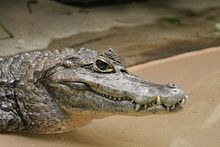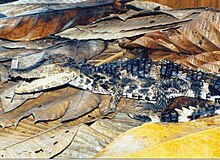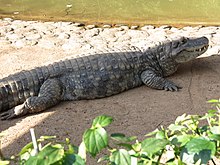pms
nòm ant ël fil

A caiman (/ˈkeɪmən/; also cayman as a variant spelling)[1] is an alligatorid belonging to the subfamily Caimaninae, one of two primary lineages within the Alligatoridae family, the other being alligators. Caimans inhabit Mexico and Central & South America from marshes and swamps to mangrove rivers and lakes. They have scaly skin and live a fairly nocturnal existence. They are relatively small-sized crocodilians with an average maximum weight of 6 to 40 kg (13 to 88 lb) depending on species, with the exception of the black caiman (Melanosuchus niger), which can grow more than 4 m (13 ft) in length and weigh in excess of 1,000 kg (2,200 Ib). The black caiman is the largest caiman species in the world and is found in the slow-moving rivers and lakes that surround the Amazon basin. The smallest species is the Cuvier's dwarf caiman (Paleosuchus palpebrosus), which grows to 1.2 to 1.5 m (3.9 to 4.9 ft) long. There are six different species of caiman found throughout the watery jungle habitats of Central and Southern America. The average length for most of the other caiman species is about 2 to 2.5 m (6.6 to 8.2 ft) long.
Caimans are distinguished from alligators, their closest relatives, by a few defining features: a lack of a bony septum between the nostrils, ventral armor composed of overlapping bony scutes formed from two parts united by a suture, and longer and sharper teeth than alligators, plus caimans tend to be more agile and crocodile-like in their movements.[2] The calcium rivets on caiman scales make their hides stiffer.
Several extinct forms are known, including Purussaurus, a giant Miocene genus that grew to 12 m (39 ft) and the equally large Mourasuchus, which had a wide duck-like snout.[3]





Caimans are predators and, like alligators and crocodiles, their diet largely consists of fish. Caimans also hunt insects, birds, small mammals and reptiles.
Due to the large size and ferocious nature of caimans, they have few natural predators within their environments. Humans are the main predators of caimans, as they have been hunted for their meat and skin. Jaguars, anacondas and crocodiles are the only other predators of caimans, but they usually prey on the smaller specimens. During summer or droughts, caimans may dig a burrow and go into a form of summer hibernation called aestivation.
Female caimans build a large nest in which to lay their eggs. These nests can be more than 1.5 m (4.9 ft) wide. Female caimans lay between 10 and 50 eggs, which hatch within about six weeks. Once they have hatched, the mother caiman takes her young to a shallow pool of water, where they can learn how to hunt and swim.

Caimaninae is cladistically defined as Caiman crocodylus (the spectacled caiman) and all species closer to it than to Alligator mississippiensis (the American alligator).[4][5] This is a stem-based definition for caimaninae, and means that it includes more basal extinct caimanine ancestors that are more closely related to living caimans than to alligators.
Below is a cladogram showing the phylogeny of Caimaninae, modified from Hastings et al. (2013).[6]
Alligatoridae Caimaninae crown group caimansPaleosuchus palpebrosus Cuvier's dwarf caiman
Paleosuchus trigonatus Smooth-fronted caiman
†Mourasuchus spp.
Caiman crocodilus Spectacled caiman
Caiman yacare Yacare caiman
Caiman latirostris Broad-snouted caiman
Melanosuchus niger Black caiman
A caiman (/ˈkeɪmən/; also cayman as a variant spelling) is an alligatorid belonging to the subfamily Caimaninae, one of two primary lineages within the Alligatoridae family, the other being alligators. Caimans inhabit Mexico and Central & South America from marshes and swamps to mangrove rivers and lakes. They have scaly skin and live a fairly nocturnal existence. They are relatively small-sized crocodilians with an average maximum weight of 6 to 40 kg (13 to 88 lb) depending on species, with the exception of the black caiman (Melanosuchus niger), which can grow more than 4 m (13 ft) in length and weigh in excess of 1,000 kg (2,200 Ib). The black caiman is the largest caiman species in the world and is found in the slow-moving rivers and lakes that surround the Amazon basin. The smallest species is the Cuvier's dwarf caiman (Paleosuchus palpebrosus), which grows to 1.2 to 1.5 m (3.9 to 4.9 ft) long. There are six different species of caiman found throughout the watery jungle habitats of Central and Southern America. The average length for most of the other caiman species is about 2 to 2.5 m (6.6 to 8.2 ft) long.
Caimans are distinguished from alligators, their closest relatives, by a few defining features: a lack of a bony septum between the nostrils, ventral armor composed of overlapping bony scutes formed from two parts united by a suture, and longer and sharper teeth than alligators, plus caimans tend to be more agile and crocodile-like in their movements. The calcium rivets on caiman scales make their hides stiffer.
Several extinct forms are known, including Purussaurus, a giant Miocene genus that grew to 12 m (39 ft) and the equally large Mourasuchus, which had a wide duck-like snout.
 Spectacled caiman (Caiman crocodilus)
Spectacled caiman (Caiman crocodilus)  Yacare caiman (Caiman yacare)
Yacare caiman (Caiman yacare)  Black caiman (Melanosuchus niger)
Black caiman (Melanosuchus niger)  Cuvier's dwarf caiman (Paleosuchus palpebrosus)
Cuvier's dwarf caiman (Paleosuchus palpebrosus)  Smooth-fronted caiman (Paleosuchus trigonatus)
Smooth-fronted caiman (Paleosuchus trigonatus)